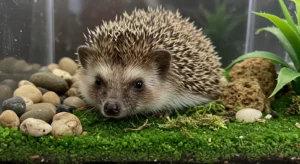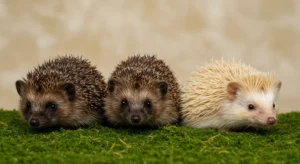Hedgehog Safety
The Dangers of Essential Oils for Hedgehogs—Which Scents to Avoid
Essential oils have gained popularity for aromatherapy, cleaning, and personal care in many homes. However, what smells pleasant and potentially beneficial to humans can be extremely dangerous, even fatal, for small pets like hedgehogs. Their sensitive respiratory systems and unique physiology make them highly susceptible to the potent compounds in these oils. Understanding the risks and which oils are particularly hazardous is vital for hedgehog safety.
Hedgehog Respiratory Sensitivity
Hedgehogs have delicate respiratory systems adapted for sniffing close to the ground. Strong airborne scents, especially the concentrated volatile organic compounds (VOCs) released by essential oil diffusers or sprays, can easily irritate their nasal passages, throat, and lungs. This irritation can lead to inflammation, breathing difficulties, and potentially severe respiratory distress. Furthermore, their small body size means even small amounts of inhaled toxins can have a disproportionately large effect.
Why Are Essential Oils Dangerous?
Essential oils are highly concentrated plant extracts containing potent chemical compounds like phenols, ketones, terpenes, and others.
- Respiratory Irritation: As mentioned, airborne particles can directly irritate sensitive tissues.
- Neurological Effects: Certain compounds (like ketones, phenols) can be neurotoxic, potentially causing tremors, seizures, lethargy, or balance problems if inhaled or absorbed.
- Liver Damage: Hedgehogs lack certain liver enzymes necessary to metabolize compounds found in many essential oils (particularly phenols and some terpenes). This means the toxins can build up in their system, leading to liver damage or failure. This metabolic difference is a key factor in understanding hedgehog-specific toxicity risks.
- Skin Irritation/Burns: Direct contact with undiluted or even diluted oils can cause skin irritation or chemical burns. Hedgehogs may also ingest oils while grooming if it gets on their quills or feet.
- Organ Damage: Besides the liver, other organs can be affected by systemic toxicity.

Specific Risks Explained
- Diffusion: Actively diffusing oils (ultrasonic, heat, nebulizing) releases micro-droplets into the air, posing a high inhalation risk, especially in enclosed spaces. This is generally considered the most dangerous form of exposure for hedgehogs.
- Sprays/Cleaners: Using essential oils in cleaning solutions or room sprays puts particles into the air and onto surfaces the hedgehog might contact.
- Topical Application (on Humans): Oils applied to your skin can transfer to the hedgehog during handling.
- Passive Diffusion: Reed diffusers or plugins still release compounds into the air, albeit potentially more slowly.
Commonly Cited Unsafe Oils
While it’s safest to avoid *all* essential oil exposure around hedgehogs, some are known to be particularly toxic to pets due to their chemical composition. This list is **not exhaustive** but includes frequently problematic oils:
- Tea Tree (Melaleuca): Highly toxic, known to cause neurological issues, paralysis, liver damage. **NEVER use near hedgehogs.**
- Pine Oils: Contain phenols and terpenes harsh on the respiratory system and liver.
- Citrus Oils (Lemon, Orange, Grapefruit, Lime, Bergamot): Contain d-limonene, can cause liver damage, skin irritation, neurological symptoms.
- Peppermint: Contains phenols, can cause respiratory distress and neurological issues.
- Cinnamon/Cassia: Skin and mucous membrane irritant, potential liver effects.
- Clove: Contains eugenol (phenol), liver toxicity, potential neurological effects.
- Eucalyptus: Respiratory irritant, potential neurological effects.
- Wintergreen/Birch: Contain methyl salicylates (aspirin-like compounds), highly toxic.
- Ylang Ylang: Potential neurological and cardiovascular effects.
- Pennyroyal: Highly toxic, known abortifacient and liver/neurotoxin.
“Natural” Does Not Mean Safe: Essential oils are natural but highly concentrated. Their potency is precisely why they pose a risk to sensitive pets. Assuming safety because they are plant-derived is a dangerous mistake when it comes to safe hedgehog environmental practices.
Safer Alternatives for Scent
If you enjoy scents in your home, consider pet-safer options used *away* from the hedgehog’s cage and airspace:
- Good Ventilation: Simply opening windows for fresh air is the safest option.
- Baking Soda: Excellent for absorbing odors naturally.
- Simmer Pots: Simmering safe spices like cinnamon sticks (not oil!) or fruit peels in water on the stove (ensure it doesn’t boil dry). Keep this activity far from the hedgehog’s room.
- Pet-Safe Air Fresheners: Research products specifically labeled as safe for use around small animals, but use even these with caution and ensure good ventilation. Avoid aerosol sprays.
What If Exposure Occurs?
If you suspect your hedgehog has been exposed to essential oils (e.g., knocking over a bottle, being in a room with a diffuser) and shows any signs of illness (lethargy, difficulty breathing, tremors, drooling, skin irritation):
- Remove from Source Immediately: Move the hedgehog to a separate, well-ventilated room with fresh air.
- Contact Vet Urgently: Call your exotic pet veterinarian or an animal poison control center right away. Time is critical.
- Do NOT Induce Vomiting: Unless specifically instructed by a vet.
- Identify the Oil: Know which oil was involved if possible, as this helps the vet determine treatment.
Conclusion: Avoidance is Key
Given the significant risks and the difficulty hedgehogs have in metabolizing many compounds in essential oils, the safest approach is complete avoidance. Do not use diffusers, sprays, or potent oils topically in areas your hedgehog inhabits or where you handle them. Prioritizing your hedgehog’s respiratory health and overall safety means choosing alternatives to essential oils in your home environment.
Toxicity information based on veterinary toxicology resources (e.g., Pet Poison Helpline, ASPCA Animal Poison Control) regarding essential oil dangers for small animals and pets with specific metabolic limitations. Lists of unsafe oils commonly cited across multiple veterinary sources.
















